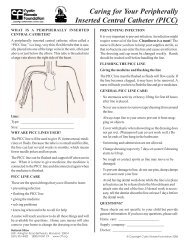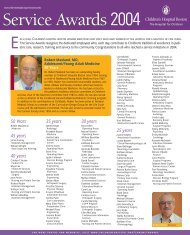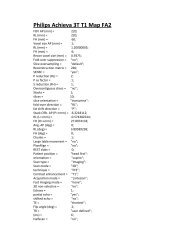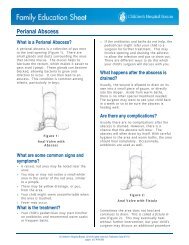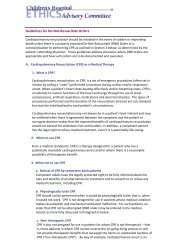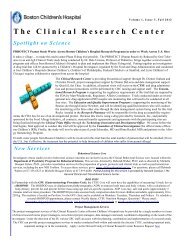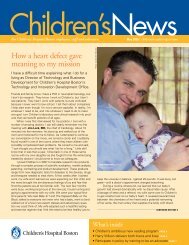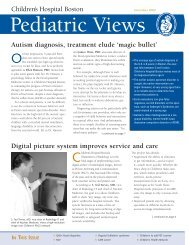cancer and a cure - Children's Hospital Boston
cancer and a cure - Children's Hospital Boston
cancer and a cure - Children's Hospital Boston
You also want an ePaper? Increase the reach of your titles
YUMPU automatically turns print PDFs into web optimized ePapers that Google loves.
The fine line between<br />
<strong>cancer</strong> <strong>and</strong> a <strong>cure</strong><br />
Photos: Mark Ostow<br />
More than any other type of <strong>cancer</strong>,<br />
brain tumors are like Rubik’s Cubes,<br />
those six-sided, multi-colored puzzles that<br />
require you to turn the pieces until each<br />
side is a solid color. The challenge with the<br />
Rubik’s Cube is to complete more than one<br />
color at a time because, while each twist<br />
brings you closer to finishing one side, it<br />
invariably takes you further from complet-<br />
ing the others.<br />
Doctors who treat children with brain...<br />
www.childrenshospital.org 15
Doctors today use<br />
three main tools in<br />
their fight against<br />
<strong>cancer</strong>: surgery,<br />
radiation <strong>and</strong><br />
chemotherapy. The<br />
sidebars describe<br />
the experiences<br />
that Chris Johnson<br />
<strong>and</strong> Mary Coffin<br />
have had with<br />
those treatments.<br />
Surgery<br />
Chris has undergone<br />
three surgeries to<br />
remove the original<br />
tumor <strong>and</strong> two<br />
recurrences. The<br />
third surgery was<br />
done with intraoperative<br />
MRI (see page<br />
18). Chris is now<br />
missing about a<br />
quarter of his brain.<br />
Mary had one<br />
surgery to remove<br />
the brain tumor <strong>and</strong><br />
a biopsy of her<br />
spinal tumor.<br />
16<br />
tumors face the same difficulty: the desire to do whatever<br />
it takes to <strong>cure</strong> a child’s disease must be weighed against<br />
the all-too-real physical consequences of attaining that<br />
<strong>cure</strong>.<br />
But there is hope. Today at Children’s <strong>Hospital</strong><br />
<strong>Boston</strong>, diagnostic tools allow tumors to be detected<br />
sooner <strong>and</strong> more accurately; new technologies help surgeons<br />
remove as much tumor as possible without damaging<br />
healthy tissue; radiation <strong>and</strong> chemotherapy are more<br />
precise; <strong>and</strong> the human genome has been decoded, raising<br />
the possibility that <strong>cancer</strong> can be detected <strong>and</strong> treated<br />
at its most basic level. But the question remains: Will any<br />
of this make a difference?<br />
Inelegant solutions<br />
While progress has been relatively rapid for other childhood<br />
<strong>cancer</strong>s such as acute lymphoblastic leukemia,<br />
which now has survival rates of more than 80 percent,<br />
inroads have come more slowly for brain tumors. Even<br />
though they continue to be relatively rare—with fewer<br />
than 2,000 new cases diagnosed nationwide in children<br />
each year—brain tumors are now the leading cause of<br />
death from childhood <strong>cancer</strong>.<br />
And these numbers don’t take into account the side<br />
effects of treating the disease. Adults with brain tumors<br />
who are treated with the three traditional <strong>cancer</strong><br />
therapies of surgery, chemotherapy <strong>and</strong> radiation can<br />
expect an array of problems ranging from hair loss <strong>and</strong><br />
nausea to vision problems <strong>and</strong> seizures. But the same<br />
treatments in children—whose brains are still<br />
developing—can also have a significant effect on<br />
cognitive <strong>and</strong> physical development.<br />
The facts about current treatments speak for themselves:<br />
A recent National Cancer Institute survey of more<br />
than 1,800 children with brain tumors—all of whom survived<br />
at least five years—found that nearly a third<br />
suffered seizures <strong>and</strong> blackouts; 37 percent had headaches<br />
<strong>and</strong> migraines; a sizable minority suffered hearing loss or<br />
blindness; 70 percent diagnosed before age 3 required special<br />
education or learning-disabled classroom settings;<br />
<strong>and</strong>, largely because more children are surviving their<br />
original tumors, secondary tumors caused by radiation<br />
<strong>and</strong> chemotherapy are on the rise.<br />
It is because of these after-effects that brain tumor<br />
specialists find themselves tiptoeing through a minefield,<br />
trying to balance the benefits of each treatment against its<br />
side effects. The ability to attain clear <strong>and</strong> concise<br />
pictures of the tumor <strong>and</strong> the healthy brain around it is<br />
hampered by the fact that children often can’t sit still for<br />
the hour or more it takes to complete a magnetic<br />
resonance imaging (MRI) scan. The desire to surgically<br />
remove the entire tumor is tempered by caution, lest<br />
areas that control speech or other essential functions be<br />
taken out as well. And the hope of destroying <strong>cancer</strong> cells<br />
with radiation <strong>and</strong> chemotherapy is balanced against the<br />
fear of damaging healthy cells as well.<br />
The tales of two tumors<br />
The experiences of two Children’s patients illustrate this<br />
balancing act <strong>and</strong> prove that with brain tumors, solving<br />
one side of the Rubik’s Cube is not enough.<br />
Eight years ago, Chris Johnson was the 12-year-old<br />
all-star catcher for his town baseball team when he started<br />
seeing two pitches coming at him instead of one. At<br />
first he was told the cause was dehydration, then a sinus<br />
infection. But the double vision <strong>and</strong> headaches didn’t go<br />
away, so Chris had an MRI that revealed an orange-sized<br />
tumor on his temporal lobe.<br />
He was diagnosed with glioblastoma multiforme,<br />
which is, in the words of his oncologist Mark Kieran,<br />
MD, PhD, “arguably the most malignant tumor in<br />
humans.” Fortunately, due to the tumor’s location, it was<br />
able to be removed entirely, <strong>and</strong> despite a median<br />
survival of only seven to nine months, Chris has survived<br />
for more than eight years. In that time, he has had two<br />
recurrences (<strong>and</strong> subsequent surgical removals) in the<br />
same location <strong>and</strong> has undergone several rounds of<br />
chemotherapy <strong>and</strong> radiation. And even though the longterm<br />
side effects of his treatments have been relatively<br />
Dream ❘ Fall/Winter 2002
minor compared to what many kids face, he still has suffered<br />
seizures, loss of peripheral vision, <strong>and</strong> has some difficulty<br />
processing information.<br />
The same summer Chris was diagnosed, an 8-yearold<br />
New Hampshire girl named Mary Coffin also started<br />
having vision problems in her right eye. Her optometrist<br />
diagnosed her with lazy eye, but when patching didn’t<br />
improve Mary’s vision, she had an MRI that revealed a<br />
tumor on her optic chiasm.<br />
She was diagnosed with an astrocytoma, which is a<br />
less aggressive version of Chris’s disease. Surgeons<br />
couldn’t remove the entire tumor because doing so would<br />
have caused Mary to go blind, but stereotactic radiation<br />
was effective in stabilizing the disease for nearly five years.<br />
In 1999, Mary’s tumor not only came back, but spread to<br />
her spine. Further treatment stabilized the disease, but in<br />
the spring of 2001, the tumor in her spine progressed <strong>and</strong><br />
caused so much damage that Mary became paraplegic.<br />
In an attempt to stop the tumor growth, doctors<br />
put Mary on a new type of chemotherapy that has been<br />
successful in slowing some forms of leukemia. The initial<br />
results were promising, as the tumor shrank significantly<br />
over the next three months <strong>and</strong> the pain she had been<br />
experiencing subsided. But in January 2002, the tumor<br />
returned <strong>and</strong> Mary went back on chemotherapy.<br />
Scott Pomeroy, MD, PhD, director of Neuro-Oncology<br />
at Children’s, has treated both patients, <strong>and</strong> struggles<br />
with the difficulties he <strong>and</strong> others face when caring for<br />
“I have a lot of faith that things will<br />
go well. I told my mother once that<br />
I wouldn’t die from <strong>cancer</strong>.”<br />
Despite being diagnosed with a brain tumor eight years ago <strong>and</strong><br />
having two recurrences, Chris Johnson has survived with few<br />
major side effects. He is currently at St. Anselm College in<br />
Manchester, N.H., where he is studying criminal justice in the<br />
hope of being a prosecutor <strong>and</strong>, eventually, a judge. He meets<br />
regularly with Tom Hammond (left), his senior advisor <strong>and</strong> Tony<br />
Smith (center), his senior seminar professor, to discuss his future.<br />
His oncologist, Mark Kieran says, “We wish we knew exactly<br />
what it was about Chris’s tumor that made it stop so we could<br />
do it more often. He will teach us things that we’re still trying to<br />
learn how to ask. There is a way to stop these tumors, we just<br />
haven’t figured out how yet.”<br />
children with brain tumors. “We have had some success<br />
with both Chris <strong>and</strong> Mary. They’re both fighters with<br />
tumors we’ve been able to treat, but our biggest<br />
frustration is the patients we don’t have an impact on.<br />
We can’t push the treatments further, <strong>and</strong> barring some<br />
gigantic breakthrough, there doesn’t seem to be a<br />
solution to the problem.”<br />
Kieran, who is director of Pediatric Neuro-Oncology<br />
at Dana-Farber/Children’s <strong>Hospital</strong> Cancer Care<br />
(DF/CHCC), puts it another way. “For 30 years we’ve<br />
thought we were just around the corner from a <strong>cure</strong>, but<br />
<strong>cancer</strong> has taught us many times that it’s a much tougher<br />
disease than we ever guessed.”<br />
Target acquired<br />
Despite these difficulties, doctors <strong>and</strong> researchers at Children’s<br />
<strong>and</strong> its partner hospitals are working feverishly to<br />
refine current brain tumor treatments, <strong>and</strong> point to<br />
targeted therapies as the best <strong>and</strong> safest options. The<br />
term “targeted therapies” doesn’t refer to a specific treatment,<br />
but rather a way of going about treatment in general.<br />
In surgery, taking out the whole mass is easier if its<br />
exact size has been established. In radiation, beams can<br />
be made smaller <strong>and</strong> more accurate so they are pointed<br />
only at the tumor. And in looking for innovative new<br />
treatments, target only what’s wrong with the <strong>cancer</strong> cells<br />
rather than poisoning everything in the hope of killing<br />
the tumor.<br />
Radiation<br />
After his original<br />
diagnosis, Chris had<br />
six weeks of radiation,<br />
including double<br />
sessions during<br />
the final two weeks.<br />
He also has had 70<br />
total brachytherapy<br />
seeds implanted<br />
over two surgeries,<br />
<strong>and</strong> had a stereotactic<br />
blast, which is a<br />
high dose of radiation<br />
delivered all at<br />
once. To insure<br />
accuracy, an<br />
aluminum halo is<br />
screwed into the<br />
patient’s skull <strong>and</strong><br />
the halo is se<strong>cure</strong>d<br />
to the radiation table.<br />
Mary had six weeks<br />
of stereotactic radiation<br />
after her original<br />
diagnosis in<br />
1994. Since her<br />
tumor relapsed, she<br />
has had radiation to<br />
her brain <strong>and</strong> spine.<br />
www.childrenshospital.org 17
Chemotherapy<br />
Mary has undergone<br />
five different types<br />
of chemotherapy,<br />
including the traditional<br />
mix of<br />
vincristine <strong>and</strong> carboplatin,<br />
after her<br />
recurrence in 1999.<br />
She was also on<br />
Gleevec, a next-generation<br />
chemo that<br />
has shown success<br />
in treating some<br />
forms of <strong>cancer</strong>.<br />
Chris underwent 11<br />
months of<br />
chemotherapy<br />
immediately following<br />
his diagnosis <strong>and</strong><br />
first surgery.<br />
18<br />
One targeted therapy that has been successful in<br />
surgery is intraoperative MRI, a relatively new technology<br />
that helps surgeons remove brain tumors without taking<br />
out healthy areas of the brain. The system puts the operating<br />
table <strong>and</strong> surgeons between two large, doughnutshaped<br />
MRI scanners that provide up-to-the-second<br />
images of a patient’s brain tumor during the operation.<br />
Peter Black, MD, PhD, neurosurgeon-in-chief at both<br />
Children’s <strong>and</strong> Brigham <strong>and</strong> Women’s <strong>Hospital</strong>, uses the<br />
system often <strong>and</strong> knows its benefits. “Intraoperative<br />
imaging is a quantum leap for us because we can make a<br />
three-dimensional reconstruction of the tumor that<br />
shows us exactly where <strong>and</strong> how big it is,” he says.<br />
“Before this advance, we often didn’t know we were missing<br />
some of the tumor, so there’s no question this<br />
technology helps surgeons be more precise <strong>and</strong> accurate.”<br />
Black knows it is only the first step. “New technology<br />
like this makes you think about how you can do things<br />
less invasively <strong>and</strong> with less injury,” says Black. “New <strong>and</strong><br />
potentially important treatments come from being able to<br />
image the target exactly <strong>and</strong> remove it cleanly.”<br />
Karen Marcus, MD, chief of the Division of Radiation<br />
Oncology, also has seen the development of targeted<br />
therapies in radiation. In fact, she says, the biggest<br />
advances in her field have been treatments in which radiation<br />
beams are arranged so they match the shape of the<br />
tumor. “Instead of the big square radiation fields we used<br />
“I haven’t put my health aside or<br />
pretended nothing is happening.<br />
I’ve just tried to be a kid <strong>and</strong> have<br />
fun with my friends.”<br />
Sixteen-year-old Mary Coffin has made the honor roll<br />
throughout her eight-year illness <strong>and</strong> was president of<br />
the student council at her middle school in Henniker,<br />
N.H. Coming from a small town has helped Mary share<br />
her battle with many of those close to her. She’s been<br />
friends with Drew Ellis (left) since kindergarten, <strong>and</strong> other<br />
classmates have gone to radiation treatments with her<br />
over the years. Last summer, she went to a Red Sox<br />
game with Drew, her mother W<strong>and</strong>a, <strong>and</strong> other patients<br />
from Dana-Farber/Children’s <strong>Hospital</strong> <strong>cancer</strong> care.<br />
Mary recently took up impressionist painting <strong>and</strong> is<br />
writing her life story.<br />
to deliver,” she says, “we use many small beams from different<br />
angles that are aimed at one area. That way the<br />
total dose around the target is what we want, but the<br />
dose to other parts of brain is very limited.”<br />
Marcus points to four examples: stereotactic radiotherapy<br />
(SRT), which involves the delivery of multiple<br />
doses of very focused radiation; stereotactic radiosurgery<br />
(SRS), which delivers a single, large dose of focused radiation<br />
all at once; intensity modulated radiation therapy<br />
(IMRT), where computers deliver radiation so different<br />
areas of the tumor get different amounts of radiation<br />
based on where the tumor is the most dense; <strong>and</strong><br />
brachytherapy, a treatment used on tumors that have<br />
already been treated with external beam radiation that<br />
involves the surgical implantation of radioactive seeds<br />
into the tumor. The seeds provide a high dose of<br />
radiation to the <strong>cancer</strong> cells, while the healthy tissue next<br />
to the cells gets almost none.<br />
After surgery <strong>and</strong> radiation, the last of the three traditional<br />
<strong>cancer</strong> treatments is chemotherapy. Its use in brain<br />
tumors has become more prominent in the last 15 to 20<br />
years, but varies based on the tumor type. In some tumors<br />
it is used to delay radiation until the child is older because<br />
chemotherapy causes fewer long-term side effects than<br />
radiation. In other tumors it is used intensively to treat the<br />
tumor, <strong>and</strong> in still others it has a very limited role. Many<br />
clinicians believe that if genetic profiling of tumors
(discussed below) can be used to identify which tumors<br />
will respond to traditional chemotherapy <strong>and</strong> surgery<br />
alone, the role of harmful radiation therapy can be reduced<br />
or even eliminated in the treatment of some tumors.<br />
A new tool<br />
As both a clinician <strong>and</strong> researcher, Pomeroy has a unique<br />
perspective on what it may finally take to stop <strong>cancer</strong> in<br />
general <strong>and</strong> brain tumors specifically. “The future of<br />
treatment lies in underst<strong>and</strong>ing the biology of tumors<br />
<strong>and</strong> attacking what’s causing the <strong>cancer</strong>,” he says.<br />
With that in mind, he has worked closely with<br />
Todd Golub, MD, assistant in Medicine at Children’s <strong>and</strong><br />
an oncologist at the Dana-Farber Cancer Institute, on a<br />
technique Golub has revolutionized called microarray<br />
gene expression profiling. Spurred on by the unlocking of<br />
the human genome, the process uses computers to measure<br />
the RNA in tissue. RNA is turned into the proteins<br />
that build the body’s cells. From this, scientists hope to<br />
identify which proteins are guiding the growth of tumors<br />
so they can stop the development of those proteins <strong>and</strong>,<br />
hopefully, the tumor.<br />
Golub envisions this technology giving oncologists<br />
around the world a st<strong>and</strong>ard, objective set of criteria for<br />
diagnosing <strong>cancer</strong>; one that moves away from the current<br />
system of classifying a tumor based on its tissue of origin<br />
<strong>and</strong> how its cells look under a microscope.<br />
One early example of the technology’s potential<br />
comes from Golub <strong>and</strong> Pomeroy, who recently published<br />
a paper in the journal Nature detailing how they<br />
categorized different types of medulloblastomas (a<br />
common brain tumor in children) based on their genetic<br />
signatures. This then allowed them to determine at diagnosis<br />
which tumors would be aggressive <strong>and</strong> which would<br />
grow more slowly. While they haven’t used this information<br />
in a clinical setting yet, they hope to do so in the<br />
next five years. They plan to tailor treatment regimens so<br />
patients with less aggressive tumors can be treated with<br />
lower doses of chemotherapy <strong>and</strong> radiation, thus saving<br />
them from the side effects of treatments they don’t need.<br />
The next goal for gene profiling is to use the information<br />
to develop, in Golub’s terms, “molecularly targeted<br />
therapies that go after what’s broken in the <strong>cancer</strong> cell,<br />
not with an atom bomb, but with a magic bullet.” As an<br />
example, he points to Gleevec, a drug developed without<br />
the benefit of gene profiling, but one that has been<br />
successful in treating acute myeloid leukemia (AML). It<br />
specifically targets the molecular problem that causes it,<br />
<strong>and</strong> has been shown to slow the progress of AML while<br />
causing very few side effects.<br />
Golub is encouraged by what he sees with Gleevec.<br />
“It shows that different <strong>cancer</strong>s have Achilles’ heels, <strong>and</strong><br />
by using gene expression profiling to underst<strong>and</strong> what is<br />
causing a specific disease on the genetic level, we should<br />
be able to target its weakness effectively <strong>and</strong> cause fewer<br />
side effects. Now we need to develop such drugs for<br />
brain tumors.”<br />
Pomeroy believes gene expression profiling,<br />
combined with other techniques that lead to a molecular<br />
underst<strong>and</strong>ing of <strong>cancer</strong>, may be the breakthrough that<br />
has eluded doctors for generations. “I can’t think of<br />
another way that’s more likely to succeed. Going step by<br />
step <strong>and</strong> underst<strong>and</strong>ing exactly what the problem is <strong>and</strong><br />
then specifically dealing with that problem is the way to<br />
go,” he says. “I have a lot of hope. I think we’re heading<br />
in the right direction, <strong>and</strong> that it’s only a matter of time<br />
before this will pay off.”<br />
—Matthew Cyr<br />
Editor’s note: In November 2002, Mary Coffin lost her eight<br />
year battle with <strong>cancer</strong>. Children’s <strong>Hospital</strong> extends its heartfelt<br />
condolences to the Coffin family.<br />
For more information on supporting the Neurology Leadership<br />
Fund, which supports research in pediatric brain tumors <strong>and</strong><br />
neurologic disorders, contact Donna Richardson in the<br />
Children’s <strong>Hospital</strong> Trust at (617) 355-2061 or at<br />
donna.richardson@chtrust.org.<br />
In addition to gene<br />
expression profiling,<br />
there are a number of<br />
other promising areas<br />
in <strong>cancer</strong> study <strong>and</strong><br />
treatment.<br />
Proteomics Measuring<br />
proteins (which<br />
decide what functions<br />
a cell can perform) in<br />
a tumor. Cancer typically<br />
mutates proteins.<br />
Genomics Identifying<br />
abnormal DNA<br />
sequences that may<br />
be responsible for<br />
mutant proteins. Helps<br />
identify inherited<br />
genes that predispose<br />
someone to <strong>cancer</strong>.<br />
Antiangiogenic therapies<br />
Using naturally<br />
occurring or chemical<br />
substances to cut off<br />
a tumor’s blood supply.<br />
Gene therapy<br />
Introducing a foreign<br />
gene into the body to<br />
correct a defective<br />
gene, stimulate the<br />
immune system or<br />
make the body resistant<br />
to chemo so higher<br />
doses can be given.<br />
Immunotherapy<br />
Stimulating the immune<br />
system so the body’s<br />
natural defenses will<br />
recognize <strong>and</strong> attack<br />
<strong>cancer</strong> cells.<br />
Small molecule<br />
inhibitors Drugs that<br />
block proteins’ signaling<br />
components to<br />
keep them from triggering<br />
<strong>cancer</strong>’s out-<br />
19<br />
of-control cell division.





